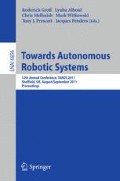Abstract
A biologically inspired model of head direction cells is presented and tested on a small mobile robot. Head direction cells (discovered in the brain of rats in 1984) encode the head orientation of their host irrespective of the host’s location in the environment. The head direction system thus acts as a biological compass (though not a magnetic one) for its host. Head direction cells are influenced in different ways by idiothetic (host-centred) and allothetic (not host-centred) cues. The model presented here uses the visual, vestibular and kinesthetic inputs that are simulated by robot sensors. Three test cases are presented that cover different state combinations of the inputs. The test results are compared with biological observations in previous literature.
Access this chapter
Tax calculation will be finalised at checkout
Purchases are for personal use only
Preview
Unable to display preview. Download preview PDF.
References
Arleo, A., Gerstner, W.: Spatial orientation in navigating agents: Modeling head-direction cells. Neurocomputing 38-40(1-4), 1059–1065 (2001)
Biegler, R., Morris, R.G.M.: Landmark stability is a prerequisite for spatial but not discrimination learning. Nature 361, 631–633 (1993)
de Castro, L.N., Von Zuben, F.J. (eds.): Recent Developments in Biologically Inspired Computing. Idea Group Publishing, USA (2005)
Degris, T., Lachèze, L., Boucheny, C., Arleo, A.: A spiking neuron model of head-direction cells for robot orientation. In: Proceedings of the Eighth International Conference on the Simulation of Adaptive Behavior, from Animals to Animats, pp. 255–263. MIT Press, Cambridge (2004)
Etienne, A.S., Maurer, R., Saucy, F.: Limitations in the assessment of path dependent information. Behaviour 106, 81–111 (1988)
Etienne, A.S., Maurer, R., Séguinot, V.: Path integration in mammals and its interaction with visual landmarks. Journal of Experimental Biology 199, 201–209 (1996)
Goodridge, J.P., David, Touretzky, D.S., Jeremy, P.: Modeling attractor deformation in the rodent head-direction system. Journal of Neurophysiology 83, 3402–3410 (2000)
Goodridge, J.P., Dudchenko, P.A., Worboys, K.A., Golob, E.J., Taube, J.S.: Cue control and head direction cells. Behavioral Neuroscience 112(4), 749–761 (1998)
Hafting, T., Fyhn, M., Molden, S., Moser, M.-B.B., Moser, E.I.: Microstructure of a spatial map in the entorhinal cortex. Nature 436(7052), 801–806 (2005)
Mel, B.W., Koch, C.: Sigma-pi learning: on radial basis functions and cortical associative learning. In: Touretzky, D.S. (ed.) Advances in Neural Information Processing Systems, vol. 2, pp. 474–481. Morgan Kaufmann Publishers Inc., San Francisco (1990)
Morris, R.G., Garrud, P., Rawlins, J.N., O’Keefe, J.: Place navigation impaired in rats with hippocampal lesions. Nature 297(5868), 681–683 (1982)
Muller, R.U., Kubie, J.L., Ranck, J.B.: Spatial firing patterns of hippocampal complex-spike cells in a fixed environment. Neuroscience 7(7), 1935–1950 (1987)
O’Keefe, J., Dostrovsky, J.: The hippocampus as a spatial map. preliminary evidence from unit activity in the freely-moving rat. Brain Research 34(1), 171–175 (1971)
Redish, A.D., Elga, A.N., Touretzky, D.S.: A coupled attractor model of the rodent head direction system. Network: Computation in Neural Systems 7(4), 671–685 (1996)
Mizumori, S.J., Williams, J.D.: Directionally selective mnemonic properties of neurons in the lateral dorsal nucleus of the thalamus of rats. Neuroscience 13(9), 4015–4028 (1993)
Stringer, S., Trappenberg, T., Rolls, E., de Araujo, I.: Self-organizing continuous attractor networks and path integration: one-dimensional models of head direction cells. Network: Computation in Neural Systems 13(2), 217–242 (2002)
Taube, J.S.: Head direction cells and the neurophysiological basis for a sense of direction. Progress Neurobiololy 55(3), 225–256 (1998)
Taube, J., Muller, R., Ranck Jr., J.: Head-direction cells recorded from the postsubiculum in freely moving rats. i. description and quantitative analysis. Neuroscience 10(2), 420–435 (1990)
Tolman, E.C., Ritchie, B.F., Kalish, D.: Studies in spatial learning. i. orientation and the short-cut. Journal of Experimental Psychology 36, 13–24 (1946)
Trullier, O., Wiener, S., Berthoz, A., Meyer, J.: Biologically-based artificial navigation systems: Review and prospects. Progress in Neurobiology 51, 483–544 (1997)
Skaggs, W.E., Knierim, J.J., Kudrimoti, H.S., McNaughton, B.L.: A model of the neural basis of the rat’s sense of direction. Advances in Neural Information Processing Systems 7, 173–180 (1995)
Wehner, R., Menzel, R.: Do insects have cognitive maps? Annual Review of Neuroscience 13, 403–414 (1990)
Wiener, S.I., Taube, J.S. (eds.): Head direction cells and the neural mechanisms of spatial orientation. MIT Press, Cambridge (2005)
Zeidman, P., Bullinaria, J.A.: Neural models of head-direction cells. In: French, R.M., Thomas, E. (eds.) From Associations to Rules: Connectionist Models of Behavior and Cognition, pp. 165–177 (2008)
Author information
Authors and Affiliations
Editor information
Editors and Affiliations
Rights and permissions
Copyright information
© 2011 Springer-Verlag Berlin Heidelberg
About this paper
Cite this paper
Kyriacou, T. (2011). An Implementation of a Biologically Inspired Model of Head Direction Cells on a Robot. In: Groß, R., Alboul, L., Melhuish, C., Witkowski, M., Prescott, T.J., Penders, J. (eds) Towards Autonomous Robotic Systems. TAROS 2011. Lecture Notes in Computer Science(), vol 6856. Springer, Berlin, Heidelberg. https://doi.org/10.1007/978-3-642-23232-9_7
Download citation
DOI: https://doi.org/10.1007/978-3-642-23232-9_7
Publisher Name: Springer, Berlin, Heidelberg
Print ISBN: 978-3-642-23231-2
Online ISBN: 978-3-642-23232-9
eBook Packages: Computer ScienceComputer Science (R0)

